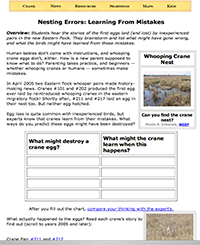Today's Report Includes:
- Class of 2008: First UL Juveniles Home! >>
- News: Reports and Photos From the Field >>
- Journal: How Can We Get Better Nesting Success? >>
- Analyze: Why Small Groups? >>
- Advice on Identifying Cranes: "Beware of the Probables" >>
-
Links: This Week's Crane Resources >>
Whoopee! The first EIGHT ultralight-led whooping cranes from the Class of 2008 arrived back in Wisconsin April 16! Sara Zimorski called to report the exciting news. Back home are #804, #814 and #818; and the St. Marks cranes #805, #812, #828, #829 and #830 (minus 826 and 813.) The same day, crane #813 reached eastern Wisconsin. Juveniles 803, 824, and 827 were still in Georgia (presumably together), where flooding has created good crane habitat. You recall that the first 2008 juveniles to reach Wisconsin were four of the Direct Autumn Release (DAR) birds, who learned the way from trusty #216 last fall. Unknown: the whereabouts of two of the 2008 UL birds, 819 and 810 (last recorded Jan. 26 in Florida).
More than half the Eastern flock is home. On April 14 Wisconsin teacher and craniac Darlene Lambert saw four Whooping cranes at Necedah NWR. "I'm still smiling," she wrote. From the refuge observation tower, Mrs. Lambert was singing all the romantic songs she could think of "to encourage LOTS of nesting activity." Why? You'll find out as you read on . . .
|

|
|
| Western
Flock News>> |
Which
cranes in the Eastern flock are the latest arrivals in Wisconsin? Many
cranes of the Western flock are in the Central Flyway. See
the
latest migration map! >> |
Eastern
Flock News>> |
•Nesting Errors: Learning From Mistakes >>
•Hoping for Hatches >>
The Eastern flock has 12 potential breeding pairs (old enough to lay eggs). As of April 15 nine pairs of Whooping cranes are nesting in Wisconsin, eight of them incubating eggs. This is the natural way to grow the flock, and very good news. After last year's failed nests, everyone has their fingers crossed — but they are doing more than that.
Joe Duff of Operation Migration tells us an active program is underway to promote successful breeding — or at least to find out if there is a problem. Why? The Project Direction Team and the Recovery Team feel that another year of nest abandonment would not bode well for the project. They hope to find out why the cranes left their eggs and prevent another summer of failed nests. Read what the team is doing in Hoping for Hatches >>. Then:
- Think about each of the actions listed. Do you think experts are making a wise decision to closely study the Whooping cranes and their nests? What might be some pros? Cons? Explain.
Write your
responses in your Journal. >>
Tom Stehn reminds us: Whooping cranes usually migrate in small groups of 1-5 birds. However, whooping cranes at the end of a migration flight may actually find other whooping cranes already on the ground as they look for a suitable place to spend the night, and join them. Groups of between 20-30 whooping cranes thus have been known to occur occasionally. These large groups may associate for a day or two, but usually will break up into the more typical small groups of 1-5 as the migration resumes." Tom gives you this question:
Why
don't whooping cranes form big flocks and migrate together? Think
about two things:
1. What are advantages and disadvantages of
being in a larger flock?
2.
Based on the flight characteristics of Whooping cranes that use thermal
currents and soaring flight, are there advantages to flying in a
large group formation, as geese do?

Photo William Gudgel
- Western Flock News: >>
- Eastern Flock News: >>
- The Finish Line: Wisconsin Arrivals >>
- Current Nesting Chart: Spring 2009, Eastern Flock >>
- Nesting Research: Hoping for Hatches >>
- Nesting Errors: Learning from Mistakes >>
- Scientist Comment: Beware of the Probables >>
- Mapping
and Record Keeping: Track the Migration >>
The Next Whooping Crane Migration Update Will Be Posted on April 24, 2009.








